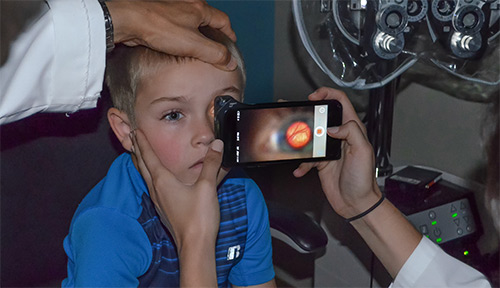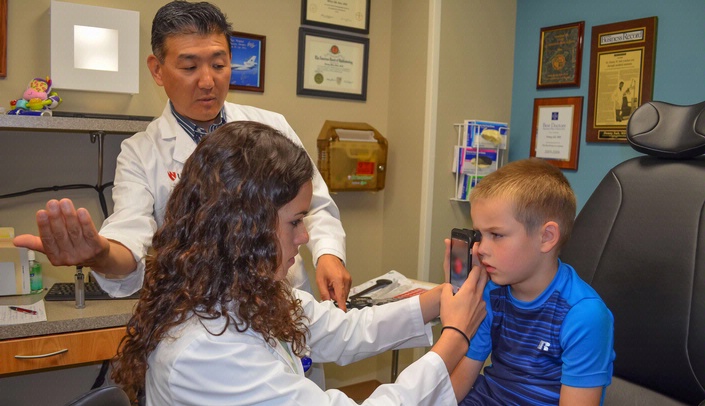An inexpensive device that attaches to smartphones and records photos and video could revolutionize how ophthalmologists teach medical students and residents and potentially provide a simple way to detect eye problems.
The small, two-inch camera attachment clips on the top of the phone and allows health professionals to examine a key area of the interior surface of the eye called the fundus. The fundus includes the central retina, optic disc, macula, fovea and the posterior pole.
 |
The smartphone camera attachment provides a clear look at the interior surface of the left eye of Barrett Kumke, a 5-year-old from Gibbon, Neb. Kumke was born with a scar on his eye, a condition called ocular toxoplasmosis. He eventually will need surgery. |
Omaha pediatric ophthalmologist, Donny Suh, M.D., has been involved in a research study published in the July edition of the Open Journal of Ophthalmology. The study looked at one of the three similar devices that are in the marketplace.
Dr. Suh is associate professor in the UNMC Department of Ophthalmology and Visual Sciences. He sees patients at Children’s Hospital & Medical Center as well as the Truhlsen Eye Institute at UNMC.
Dr. Suh uses the attachment in his practice every day to teach the students and residents. The device costs around $300-$400. In comparison, the existing equipment used by ophthalmologists to examine the optic nerve and retina would be much more expensive, he said, and is not easily portable.
He said the smartphone camera attachment has three key uses:
- As a teaching device for medical students and resident physicians;
- As a tool that referring physicians can use to document eye problems and then forward the image on to ophthalmologists for their expert opinion; and
- As a tool that would allow health professionals on medical missions in foreign countries to take an image of the eye and then forward it back to ophthalmologists for their review.
“It is a great teaching device and can potentially be used in diagnosing a variety of diseases. I think it could revolutionize the way we teach students,” Dr. Suh said. “With the ophthalmoscope, I really don’t know what the students are seeing. With the smartphone device, students can take pictures and videos of the eye. I know exactly what they are looking at.”

Amazing – what an incredibly powerful tool! Thank you for investigating and sharing what you've found!!
Enjoyed hearing more about this at lunch today. Thanks for sharing.